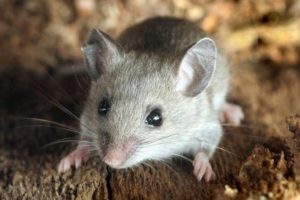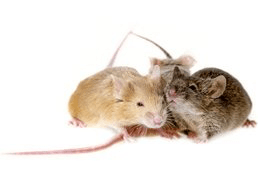Mice Removal & Info
The house mouse, one of the most detrimental pests in the United States, is second only to humans as the most common mammal in cities across the nation. House mice are notorious nibblers who climb, jump, and swim in order to get to their favorite foods, which are often found in houses, farms, open fields, and commercial buildings. They are curious and fearless creatures that will chew through walls, electrical cables, and storage containers in order to get what they want.
Biology & Behavior
The most common household rodent is the house mouse. This mouse has large ears, a pointed muzzle, and a slender body. The tail is unicolored, has little hair, and is about as long as the head and body combined.Adults weight 0.5 and 0.75 ounce and the combined length of the head and body are 2.5 to 3.5 inches long. The tail measures between three and four inches long. The feces are rod shaped, 0.125 to 0.25 inch long.Although house mice are commonly found living in structures built by humans, they are also well adapted to living outdoors. They are common inhabitants of grassy fields and cultivated grain crops. Wild populations often move into buildings when weather becomes severe. The house mouse has poor vision and is colorblind. Mice have keen senses of smell, taste, hearing, and touch. They use their sense of smell to locate food items and recognize other individual mice.Mice use their long, sensitive whiskers on the nose and above the eyes as tactile sensors. The whiskers and guard hairs enable the mice to travel easily in the dark. House mice feed on a wide range of foods, although cereals seem preferred over other items. Most mice favor grains. Supplemental food items include foods high in fat and protein, such as lard, butter, nuts, and dried meats.The two main feeding periods of mice are at dusk and dawn. Because of their small size, mice must feed several times during a 24 hour period. This means that they are active day and night. Their range is normally 10-30 feet from the nest.
Noises
What Does a Mouse Sound Like?
Mice use vocals to express emotions and relay the location of food and shelter. The noise they make most frequently is a high-pitched squeak, almost like a singing chatter, but it can change in pitch and frequency depending on what they’re trying to communicate. For example, their squeaks are faster during mating and louder when they find food.
House mice are also notorious for making scratching and scuffling noises as they move behind baseboards, drywall, and floorboards in homes. These sounds are caused by the pests’ nails digging into surfaces for grip.
Mice Sounds At Night
Mice use vocals to express emotions and relay the location of food and shelter. The noise they make most frequently is a high-pitched squeak, almost like a singing chatter, but it can change in pitch and frequency depending on what they’re trying to communicate. For example, their squeaks are faster during mating and louder when they find food.
House mice are also notorious for making scratching and scuffling noises as they move behind baseboards, drywall, and floorboards in homes. These sounds are caused by the pests’ nails digging into surfaces for grip.
Tracks

Mice have four toes on their front feet and five on their hind feet. They also have claws, which may or may not be apparent in their footprints. Mouse tracks are often accompanied by a visible trail created by the long tail of the rodent as it comes into contact with the ground.
Scat
Mouse droppings are best described as small, pellet-shaped and dark brown in color with pointed ends. Mice droppings are typically small, about ¼-inch in length. You can tell if they are fresh droppings by the color. Newer droppings will be darker and shinier while older droppings will look chalky and dry.
Damage
Domestic rodents contaminate food by defecation, destroy structures by gnawing, transmit diseases, and harbor parasites hazardous to humans and animals. Some of the diseases that rodents convey to humans are plague, murine typhus, infectious jaundice, poliomyelitis, food poisoning, rat bite fever, and rabies. Mice chew wires which create fire hazards.
Pictures
Commonly ASKED QUESTIONS?
What do you do with trapped animals?
That answer depends on the state in which you live. Each state has their own laws that dictate what we must do when it comes to controlling wildlife on your property. In some states, we can trap, transfer and release the animals. In some states we can trap the animals, but we can only release them back onto your own property. If you don’t want the animal released on your property, it must be humanely euthanized. Sometimes we don’t even need to trap the animal and a simple exclusion device (one-way door) can be installed to allow the animal to exit your home and be locked out.
How much does it cost to remove an animal?
There are a number of factors that determine pricing; location of the animal (i.e. – chimney, attic, crawl, wall void, living area), condition of the animal (i.e. – sick, aggressive, dead), location and condition of the property and time of year (i.e. – weather condition, offspring present?). Generally speaking, pricing will vary by location and species for just the animal removal and that pricing usually does not include the entry repair.
I think I have birds in my chimney, can you get them out?
The answer to that question is most likely “Yes”, but are you sure what you’re hearing is birds? Raccoons easily invade chimneys and they have their litters on the smoke shelf of fireplaces. The sounds baby raccoons make are often mistaken for birds in chimneys and removal can be difficult. The only birds that nest in chimneys are chimney swifts and they’re federally protected, so removal can’t be performed, but exclusion can be – once they depart. If you have a pre-fabricated chimney and birds fall between the cooling tubes, removal is nearly impossible.
How soon can you get here?
Office hours vary from franchise to franchise, but generally speaking, office hours are 8am – 6pm M-F and 9am – 3pm on Saturdays.
Clients Testimonials
OUR EXPERTS WILL SOLVE THEM IN NO TIME.
Have Any Pest Problems?
Navigations
Contact Information

At Critter Removers we're committed to providing you with the highest level of services and solutions to best fit your pest or critter control needs.

